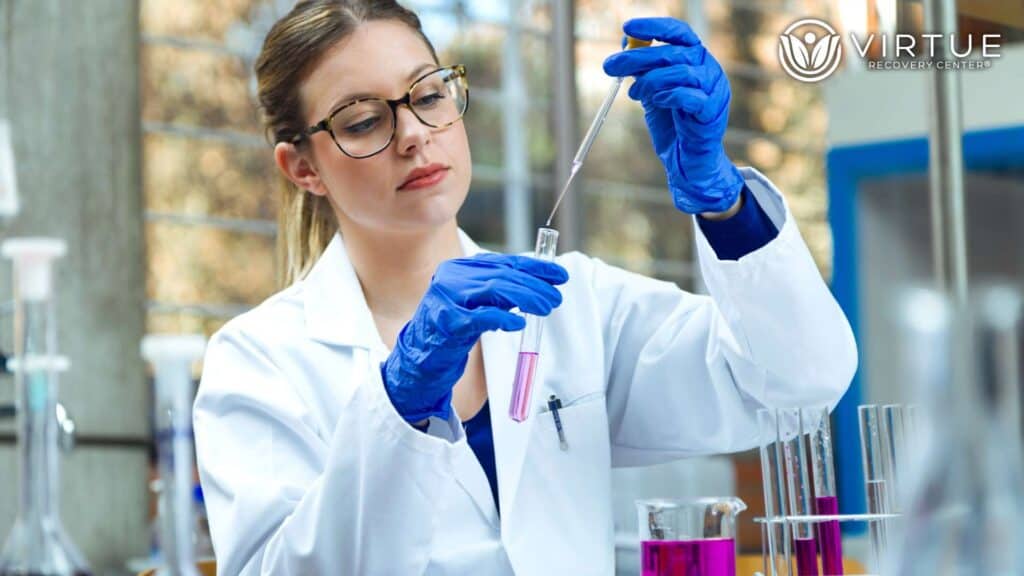
Table of Contents
Key Takeaways
- Magic mushrooms contain psilocybin, which turns into psilocin in the body.
- Psilocin is what causes the mind-altering, hallucinogenic effects.
- These chemicals affect serotonin receptors in the brain.
- The effects can be unpredictable and risky, especially for those struggling with addiction.
- Understanding the difference helps in making smart choices about health and recovery.
Introduction
Magic mushrooms have become a popular topic lately. Some people use them to feel better or to “open their minds.” Others try them just to see what happens. But before using any kind of psychedelic mushroom, it’s important to know what’s really going on inside the body. Magic mushrooms contain two main chemicals: psilocybin and psilocin. They might sound alike, but they’re not the same. Knowing the difference between psilocybin vs psilocin can help people stay safe—and make better choices when it comes to treatment and healing.What Are Magic Mushrooms?
Magic mushrooms are a type of fungus that grows in nature. They’ve been used for centuries in different cultures, often in religious or spiritual ceremonies. People eat them to experience strange thoughts, vivid images, and deep feelings. That’s because these mushrooms contain psilocybin, a chemical that causes psychedelic effects. These mushrooms go by many names—shrooms, boomers, or even sacred mushrooms. Some people use them to escape stress or feel more connected to themselves or the world. But even though they grow naturally, they’re far from harmless.Psilocybin: The Prodrug
Let’s talk about psilocybin first. Psilocybin is a prodrug. That means it doesn’t really do anything until the body changes it. Once someone swallows psilocybin, the body converts it into psilocin—the chemical that causes the mind to change. Think of psilocybin like a seed. It has potential, but nothing happens until it “blooms” inside the body. This process is fast and mostly happens in the stomach and liver. The fact that psilocybin is a prodrug helps explain why people may not feel the effects right away. It needs time to become psilocin before the psychedelic effects kick in.Psilocin: The Active Compound
Now here’s where things get interesting. Psilocin is the real star when it comes to magic mushrooms. This is the chemical that actually affects the brain. Psilocin works by changing how the brain uses serotonin, a chemical that controls mood, sleep, and how we feel. Psilocin sticks to serotonin receptors, especially in the parts of the brain that handle emotion and thinking. This is why psilocin causes people to feel strange or even see things that aren’t there. These are called hallucinogenic effects. Some people feel happy and connected. Others feel scared or confused. The effects of psilocin can last 4 to 6 hours. Sometimes longer. Some people may feel different for a whole day. Everyone’s brain reacts in its own way, so no trip is exactly the same.Psilocybin vs Psilocin: Key Differences
Let’s break it down simply:| Feature | Psilocybin | Psilocin |
| Role | Inactive until converted | Active psychedelic compound |
| Speed | Slower onset | Acts more quickly |
| Found in mushrooms | Yes | Also found, but in smaller amounts |
| Causes effects | No (not directly) | Yes |
| Chemical structure | Slightly more complex | Simpler, acts fast in body |
The Risks and Potential Dangers
Many people think mushrooms are safe because they’re “natural.” But just because something comes from nature doesn’t mean it’s safe for everyone. The effects of psilocin can be intense. Some people have a “bad trip” with scary thoughts, panic, or deep sadness. Others may feel confused or disconnected from reality. Psilocybin and psilocin may trigger mental health issues, especially in people already struggling with anxiety, depression, or trauma. There’s also a risk of using them too often or mixing them with other substances. These drugs aren’t physically addictive, but some people may start depending on them emotionally. They might keep using mushrooms to escape real-life problems or uncomfortable feelings.Medical and Therapeutic Use
Lately, scientists have been studying the therapeutic use of psilocybin in very small, controlled doses. Some say it might help with depression, anxiety, or PTSD. But this is still new, and it only happens in safe, medical environments with trained professionals. There’s a difference between natural psilocybin (from mushrooms) and synthetic psilocybin (made in labs). Doctors only use the synthetic form for research, where they can control the dose and monitor effects carefully. It’s never a good idea to try to treat yourself using magic mushrooms. The risks are too high—especially if you’re already dealing with emotional pain or addiction.Why Understanding the Difference Matters in Addiction Treatment
So, why does it matter to know the difference between psilocybin and psilocin? Because accurate knowledge can protect people, especially those already struggling with substance use or mental health. When people use these drugs without fully understanding them, they might be taking bigger risks than they realize. At Virtue Recovery Center, we believe education is part of healing. When people understand what they’re using—and how it affects their body and brain—they’re more likely to reach out for help when they need it.Conclusion
Magic mushrooms are more than just a trend. They contain powerful chemicals that can change the way your brain works. Psilocybin is a prodrug, which means it only works after turning into psilocin. And it’s psilocin that causes the psychedelic effects—good or bad. These changes can feel exciting, but they can also be dangerous, especially for someone with mental health issues or a history of addiction. If you or someone you love is struggling with substance use or experimenting with psychedelics, there is help. You don’t have to face it alone. Call Virtue Recovery Center today at 866-461-3339 to talk to someone who understands and can help.FAQs About Differences Between Psilocybin and Psilocin
What is the difference between psilocybin and psilocin in magic mushrooms?
Psilocybin is a prodrug that converts into psilocin in the body. Psilocin is the active form that produces the psychedelic effects of psilocybin mushrooms. While psilocybin itself is not responsible for the hallucinogenic effects, its conversion to psilocin is essential for the experience.How does the effect of psilocybin compare to that of psilocin?
The effects of psilocybin and psilocin are similar, as psilocin is the active metabolite responsible for the mind-altering effects. However, psilocin is considered to be about three times as potent as psilocybin when it comes to the psychedelic effects of psilocybin mushrooms.What are the common effects of magic mushrooms containing psilocybin?
The effects of magic mushrooms, which contain both psilocybin and psilocin, can include visual and auditory hallucinations, altered perception of time, and profound emotional experiences. These psychedelic effects can vary widely depending on the dose and individual factors.How can one access psilocybin for therapeutic use?
Access to psilocybin is becoming increasingly available through clinical trials and regulated programs in some areas. Psilocybin for clinical use is being researched for conditions like depression and PTSD, but legal access varies by location.Are there any risks associated with psilocybin use?
While psilocybin mushrooms are considered relatively safe in controlled settings, risks can include anxiety, paranoia, and confusion, especially in high doses. It is important to approach psilocybin use responsibly and, when possible, under professional guidance.What is the conversion process of psilocybin to psilocin?
The conversion of psilocybin to psilocin occurs in the body after ingestion. Psilocybin undergoes dephosphorylation, resulting in the formation of psilocin, which is then responsible for the psychedelic effects experienced by the user.What should I know about the dosing of psilocybin mushrooms?
Doses of psilocybin can vary based on the specific psilocybin mushroom strain and individual tolerance. It is generally recommended to start with lower doses to gauge sensitivity and effects. Being aware of psilocin levels is important, as they contribute significantly to the overall impact.What are the legal implications of psilocybin use?
The legal status of psilocybin varies widely across different regions. In some places, psilocybin is classified as an illegal substance, while others are moving towards decriminalization or regulated medical use. It is essential to understand local laws regarding drugs such as psilocybin before considering use.What Are the Long-Term Effects of Using Magic Mushrooms Containing Psilocybin and Psilocin?
Exploring the long-term effects of using magic mushrooms containing psilocybin and psilocin requires an in-depth analysis of various factors. Key among these is understanding psychedelic abuse longterm effects and risks, which can include persistent changes in mood, perception, and cognitive functions. Comprehensive studies are essential for a clearer picture.
Resources
https://www.sciencedirect.com/topics/pharmacology-toxicology-and-pharmaceutical-science/psilocin https://www.canada.ca/en/health-canada/services/substance-use/controlled-illegal-drugs/magic-mushrooms.html https://pubmed.ncbi.nlm.nih.gov/28074670/Are You Covered For Treatment?
At Virtue Recovery Center, we understand the importance of accessible care. That’s why we’re in-network with numerous private insurance companies, ensuring that your journey to recovery is supported from the start. Let us help you quickly and easily verify your insurance coverage. Begin your path to healing today.
- About the Author
- Latest Posts
Nicki Lugo, CPC, LAC, LCADC, CCTS( Clinical Director )
Nicki Lugo is currently employed as Clinical Director at Virtue Recovery Center in Las Vegas. Nicki is a licensed clinical professional counselor (CPC) in the state of Nevada and a licensed associate counselor (LAC) in the state of Arizona. She is also a licensed clinical alcohol and drug counselor (LCADC) in Nevada. Additionally, Nicki has specialized training in treating trauma and is a certified clinical trauma specialist (CCTS).
Nicki has earned a Master of Science degree in Psychology with an emphasis in Behavioral Health from the University of Phoenix and a Master of Science in Professional Counseling from Grand Canyon University. Currently, Nicki is pursuing a Doctor of Philosophy (PhD) in Counseling Education and Supervision at Grand Canyon University. Nicki’s research interests include the use of Positive Psychology interventions with dual diagnosis clients. Nicki hopes to contribute to the body of knowledge in treating substance use disorders.
Nicki’s long-term career goals include advancing in leadership roles within Virtue Recovery Center which is a quickly growing substance use disorder treatment facility. She hopes that one day her research and advocacy will help to save the lives of those who have been affected by substance use. She likes to say that advocacy is her passion and leadership is her superpower.
Key Takeaways Veterans Day began as Armistice Day in 1918 …
Key Takeaways Proper nutrition plays a vital role in addiction …
Key Takeaways Long-term sobriety is achievable with evidence-based addiction treatment …
Key Takeaways Mindfulness and meditation improve focus, emotional balance, and …
Key Takeaways Family involvement greatly improves the success of addiction …
Key Takeaways Inpatient rehab provides structured 24-hour care for addiction …


























